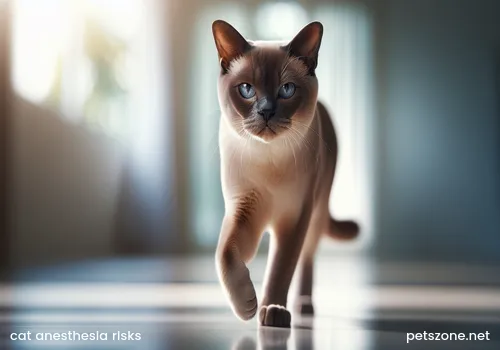Risks of Cat Anesthesia_Must-Know Precautions Before Pet Surgery
Cat anesthesia is an indispensable part of many pet surgeries and examinations, ensuring that cats do not feel pain or discomfort during the process and allowing veterinarians to operate more safely. But as pet owners, our biggest concern is the risk of anesthesia and how to maximize cat safety. In simple terms, cat anesthesia does carry certain risks, but through thorough preoperative evaluation and professional anesthesia management, these risks can be significantly reduced. Preoperative fasting, detailed health checks, choosing experienced veterinarians, and hospitals with proper equipment are all critical steps to ensure the safety of cat anesthesia.

Understanding the “Risks” and “Opportunities” of Cat Anesthesia
Just like humans need anesthesia, cats require anesthesia during surgeries, dental cleanings, imaging examinations (such as X-rays, CT, or MRI), and some painful treatments to ensure smooth operations and the cat’s comfort. Anesthesia allows cats to enter a "disconnected" state, feeling no pain and not moving, which is crucial for veterinarians to perform precise operations.
However, anesthesia is not without risk. Any medication has potential side effects, and anesthetics are no exception. According to statistics, the mortality rate for cats due to anesthesia is about 0.1% to 0.3%, slightly higher than that of dogs. Although this probability seems low, for cat lovers, even a one-in-ten-thousand risk is worrisome. These risks may include cardiovascular problems (such as hypotension, arrhythmia), respiratory issues (such as hypoxia, respiratory depression), abnormal body temperature (too low or too high), and other complications like acute kidney injury and aspiration pneumonia. In some cases, certain breeds like the brachycephalic cat have higher anesthesia risks due to their respiratory tract structure.
The good news is that with advances in veterinary medicine and widespread use of anesthesia monitoring equipment, the safety of anesthesia has greatly improved. Professional veterinary teams take numerous measures to minimize risks.
Precautions You Must Know Before Pet Surgery: Prepare in Advance
To ensure a flawless cat anesthesia process, as pet owners, we need to prepare thoroughly before surgery, just as we follow medical advice before our own operations.
1. Detailed Preoperative Examination: Conduct a Health “Baseline” Check for Your Cat
Before surgery, veterinarians usually recommend a series of preoperative examinations, similar to giving your cat a comprehensive "baseline" test. These checks help assess your cat’s overall health, detect potential health issues, and allow veterinarians to tailor the safest anesthesia plan based on the cat’s specific condition.
- Physical Examination: The vet will carefully evaluate your cat’s weight, temperature, heart rate, respiratory rate, oral cavity, abdomen, and more to understand basic physical condition.
- Blood Tests: This is a very important part. Through complete blood count and biochemical tests, vets can determine if your cat has anemia, inflammation, liver or kidney dysfunction, blood sugar issues, etc. These indicators are critical for selecting anesthetic drugs and dosages. For example, the liver and kidneys metabolize anesthetic drugs; if these organs are impaired, drug metabolism is affected, increasing risk.
- Imaging Exams: Depending on your cat’s condition and surgical needs, X-rays or ultrasounds might be required to evaluate cardiac and pulmonary function.
These test results act like a "physical report" giving veterinarians a comprehensive understanding of your cat’s health to better avoid risks.
2. Strict Fasting and Water Restriction: Prevent Choking Hazards
Preoperative fasting and water restriction are critical steps to ensure safe cat anesthesia. The primary goal is to prevent vomiting during anesthesia, which could lead to aspiration of vomit into the trachea and cause aspiration pneumonia, a potentially life-threatening complication.
Generally, healthy adult cats need to fast for 6-12 hours and avoid water for 2-4 hours before surgery. But exact times should be determined based on the cat’s age, health, and surgery type, strictly following the veterinarian’s instructions. For example, kittens fasting too long risk hypoglycemia, while senior or diabetic cats need special fasting considerations.
3. Provide Complete Medical History: Help the Veterinarian "Study the Homework"
When communicating with the vet, it’s vital to provide detailed information about your cat’s medical history, including past illnesses, allergies, ongoing medications, and vaccination status. This information helps vets assess anesthesia risk and develop appropriate plans. Sometimes minor details can influence anesthesia outcomes.
4. Prepare Hospitalization and Recovery Supplies: Make Your Cat Feel “At Home”
Depending on the surgery’s scale and your cat’s recovery, hospitalization for observation might be needed. Prepare a carrier (preferably a hard-bottom one with enough space for your cat to lie down) for transport to and from the hospital. Additionally, prepare items such as urine pads, Elizabeth collars or surgical suits (to prevent licking wounds), eye drops (since the cat’s eyes might not close fully during anesthesia and require moisture), and warm blankets.
Professional Care During Anesthesia
Cat anesthesia isn’t just a simple injection; a professional veterinary team closely monitors the entire process, like a "dedicated guardian". This includes:
- Vital Signs Monitoring: Continuously observing heart rate, respiratory rate, blood pressure, oxygen saturation, body temperature, and other vital signs, allowing prompt interventions if abnormalities occur.
- Anesthesia Depth Adjustment: Adjusting anesthetic dosage based on surgical needs and cat’s reactions to ensure appropriate anesthesia depth.
- Fluid Support: Fluid infusion during anesthesia helps maintain blood pressure, aids drug metabolism and excretion, and accelerates recovery.
Postoperative Recovery and Care: The Owner’s “Sweet Burden”
After surgery, cats enter the recovery phase, which requires attentive care from owners.
- Keep Warm: Anesthesia may cause a drop in body temperature; provide a warm and comfortable environment at home.
- Observation: Closely monitor your cat’s mental state, appetite, urination and defecation, and wound healing. Contact the vet immediately if persistent lethargy, vomiting, poor appetite, difficulty breathing, wound redness, swelling, or opening occur.
- Limit Activity: Restrict your cat’s movement to avoid strenuous activity that might reopen wounds.
- Use Elizabeth Collar / Surgical Suit: This is crucial to prevent licking or scratching the wound, avoiding infection and secondary injury.
- Follow Medication Instructions: Administer anti-inflammatory or pain medications as prescribed by the veterinarian to aid recovery.
Common Questions and Answers
- Is the mortality rate for cat anesthesia high?
Although risks exist, the mortality rate for healthy cats is relatively low, about 0.1% to 0.3%. With thorough preoperative evaluation and professional anesthesia management, risks can be further minimized. - Can senior cats undergo anesthesia?
Senior cats have a slightly higher anesthesia risk due to declining bodily functions but are not absolutely prohibited from anesthesia. Veterinarians assess their specific health to weigh pros and cons before deciding on anesthesia and surgery. Comprehensive preoperative checks are especially important for older cats. - How long does it take for cats to wake up from anesthesia?
Wake-up time depends on the type and dosage of anesthetic drugs and individual cat differences. Typically, cats anesthetized with gas anesthetics wake up relatively quickly. Most cats gradually regain consciousness within a few hours post-surgery, but full recovery might take 12 to 24 hours. - What side effects might cats have after anesthesia?
Common side effects include drowsiness, lethargy, decreased appetite, low body temperature, vomiting, and mild coughing. Most side effects resolve quickly, but persistent or severe symptoms require veterinary attention. - How long should fasting and water restriction last before surgery?
Healthy adult cats generally fast for 6-12 hours and avoid water for 2-4 hours, but exact times depend on veterinary advice. - Is preoperative examination necessary?
It’s not mandatory but highly recommended. It helps vets assess cat health, uncover hidden risks, and develop safer anesthesia plans to reduce surgical risks.
Conclusion
Although cat anesthesia carries some risk, it is not a “terrifying beast.” By fully understanding anesthesia knowledge and cooperating with veterinarians in preoperative preparation and postoperative care, we can maximize cat safety. When our cats must undergo anesthesia, giving them extra love and support and trusting the professional veterinary team help our furry friends safely pass through the “anesthesia” stage.
-560x560.webp)


